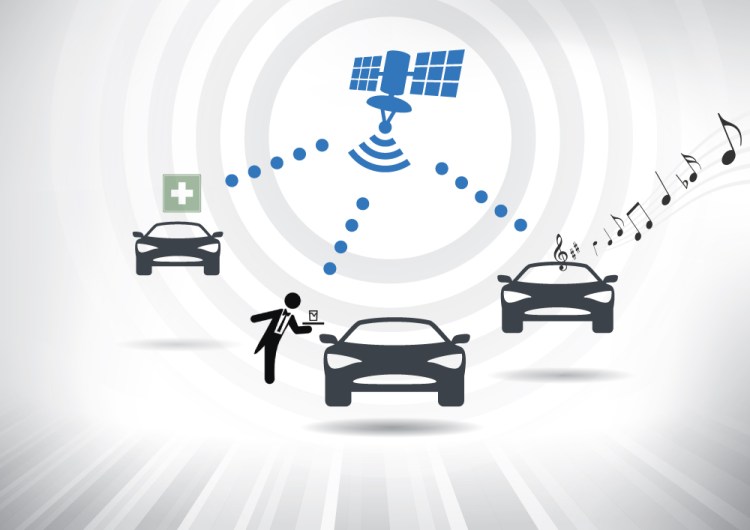There has been a lot of buzz around the increasing overlap between the automotive and consumer electronics worlds. But perhaps the simplest and most striking way to get a sense of this dynamic is to take a walk around the CES show floor. The massive booths of the auto manufacturers — which have dramatically increased in scale over the past few years and now approach production levels historically reserved for major auto shows — are the most obvious examples. But OEMs are not the only ones using CES as a venue to showcase in-car technology. There are plenty of other players in the ecosystem, including hardware and software suppliers, telco carriers, aftermarket device and accessory manufacturers, and content providers –- all vying to carve out their space in the value chain.
This convergence between cars and technology is being driven largely by the increasing ubiquity of connectivity. Cars allow us the freedom to go anywhere, and now the Internet is along for the ride. The emergence of the smartphone created broader consumer awareness and increased demand for the delivery of dynamic, IP-based services to the car. Simultaneously, connectivity is enabling communication both between cars traveling the same roads (vehicle-to-vehicle) and between cars and the roads themselves (vehicle-to-infrastructure).
Personally, I’m excited to see the continued evolution of this technology that will be on display at this year’s CES, which I think can be categorized in three broad areas of focus:
1) Safety
Progress towards the self-driving car continues, although for technical and regulatory reasons, we’re still many years away from seeing significant volumes of autonomous vehicles pilot themselves around our freeways. That said, there are some pretty remarkable advances in safety technology that are being installed in production vehicles both now and in the very near future (e.g. self-braking and lane-departure warning and correction technologies). And based on early leaks, it looks like Mercedes and Audi will be doing their part to push this farther forward with the debut of new concepts at the show.
2) Convenience
Along with making our commutes safer, technology is also making interaction with our vehicles more convenient. The BMW self-parking car that will be on display at CES should be an interesting example in this category.
Another area where we’ll see advances in terms of convenience is around the issue of how connectivity to power in-car services will be delivered: i.e. via a brought-in (handset) or built-in (embedded modem) devices. There will also be some technology on display at CES that will reframes this question by providing solutions that move away from an ‘either/or’ approach. For example, Pandora has worked with QNX and Qualcomm to build an application that delivers a great experience via both connection methods and allows for seamless switching between the two. This effort is representative of a shared objective across the ecosystem to develop flexible and convenient solutions that will encourage adoption by the broadest audience possible.
3) Entertainment
This category is nearest and dearest to me given our team’s focus on delivering the best integrated in-car experience for Pandora listeners, but that is just part of the broader movement towards IP-based delivery of content and services to the car. While I won’t go so far as to predict the near-term removal of FM radios from cars, it is obvious to me that consumers will continue to demand more and better access to the listening experiences that are enabled by the internet: namely, experiences that are personalized and tailored for their specific and individual needs.
While delivering internet-based apps to cars doesn’t represent groundbreaking technology in 2015, there will be evidence of a continued progress towards the goal of making these experiences feel more tightly integrated. Ford’s SYNC 3.0 will serve as a good example of making in-car access to applications more seamless.
***
Of course, the recognition to make technology services feel native to the driver experience isn’t limited to the entertainment category. As in-car technology continues to evolve, I expect we’ll see even more focus on making services in all categories a natural extension of the in-car experience.
It’s thrilling to be involved in such a dynamic space from a professional perspective. But I’m equally excited to walk the floor at CES purely as a consumer, marveling at both how far technology has already come and where we’re headed in the future.
As VP of automotive business development for Pandora, Geoff Snyder builds and manages relationships with the world’s top automotive brands, serving as a liaison between engineering and business development teams to make personalized radio on-the-road a reality. Since joining Pandora in 2010, he has been instrumental in the integration of Pandora into vehicles, the traditional home of radio and where consumers are demanding a new kind of music experience. Before joining Pandora, Geoff worked for 10 years with the founding team of Openlane, a company that provides software services for the auto industry, which was then acquired by Adesa. Geoff holds a B.A. in Economics from Harvard University. He also enjoys playing the guitar and is grateful his kids are young enough to think he’s good at it.
VentureBeat's mission is to be a digital town square for technical decision-makers to gain knowledge about transformative enterprise technology and transact. Learn More

